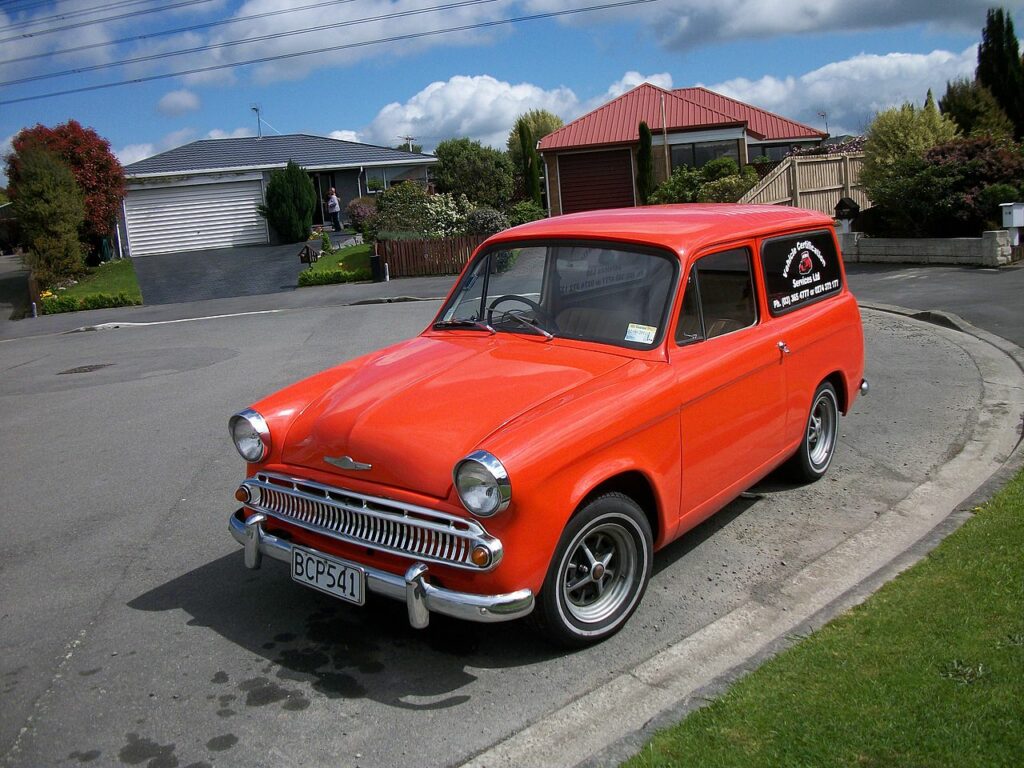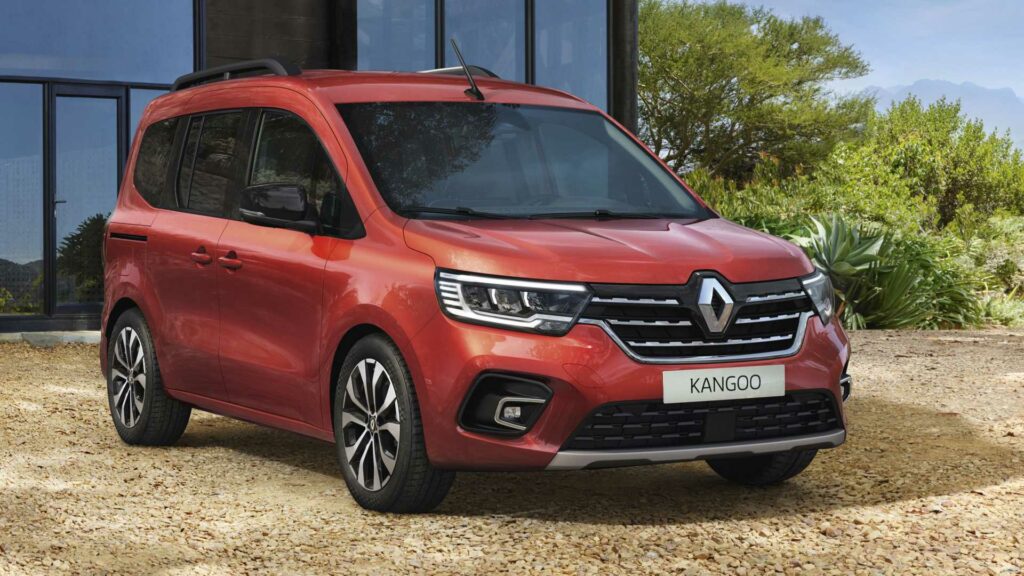
A panel van is a cargo vehicle with (up to) three distinguishing characteristics. First, it is based on a passenger car chassis. Second, there is typically only one row of seats for a driver and either one or two passengers. The area behind this row is for cargo/ goods/ freight. Third, (optionally,)there are no side windows behind the B-pillar, which is the roof support for the vehicle immediately behind the front doors.
In the past, some panel vans were almost identical to station wagons, but with glass side-windows replaced with steel, and rear seats removed. In the above photo, the windows are still in place, but painted with signage. Others featured a raised cargo area, behind the B-pillar. British panel vans, especially the Hillman Husky and Commer Cob, with their Audax design from 1960 to 1965, by Raymond Loewy (1893 – 1986), appealed most to me in the 1960s.
An aside: In part, this preference for British vehicles came from spending most summers in Kelowna, British Columbia, where my mother grew up. The community seemed to have a split personality: Half of the population drove British cars, the other half American. The first vehicle I ever drove was a Chevrolet pickup, in a farm field. I also spent a lot of time driving to beaches in the back of my aunt’s 1939 Plymouth. However, most of my mother’s friends had their own Austin A40s, Morris Minors, and even a Mini, bought in 1960.
By the 1970s, station wagons such as the Volkswagen Squareback and Volvo Amazon station wagon/ 125 and, later, Volvo 145 were also favourably viewed. This position was overtaken by the Saab 95 panel van in the 1980s and early 1990s. Our landlord in Aukra, Norway, had such a vehicle. Sometimes he would take us into Molde, about 30 km away, with Trish sitting in the passenger seat, while I lounged in the back. At the time, this was all perfectly legal. With the introduction of the Citroën Berlingo and Renault Kangoo in 1996, these two models dominated my thoughts. They no longer featured the front end, and lower seating height of a small car, but had a distinctive cockpit that improved visibility.
Part of the appeal of a panel van is that both sides and, potentially, the back, can be used to display artwork. This is part of their charm, and I have spent considerable time contemplating what I would paint on these surfaces. This characteristic does not extend to the panel van’s passenger vehicle cousin, the multi-purpose vehicle (MPV). Despite their inferiority in displaying artwork, they also have one major advantage. When they aren’t busy carrying cargo, they can also haul up to five, and sometimes even seven people. This group of vehicles also includes the Kia Soul.
Since retirement in 2017, I have been unable to justify buying a panel van. We are reduced to one vehicle in the household. Even if that one vehicle is used mainly by a single person at a time, and sometimes even two people, it has to be capable of carrying at least four people. Unfortunately, the premise of owning a panel van was dependent on having more than one vehicle in the household. Any new vehicle means that it won’t be a panel van, but could be an MPV.
Why an MPV? Apart from driving to the local store, or SpirenTEK, the local hacker space, which could be done with any vehicle, the answer is to transform it into a primitive mini-camper, that could be used to explore Trøndelag/ Norway/ Scandinavia/ Europe at a leisurely pace. There are companies that make removable camper conversions, but it is also something that could be made in almost any woodworking workshop. Thus, the MPV is the most relevant type of vehicle to consider.
There are smaller contenders: a Fiat 500 Giardiniera (if it ever makes it into production, hopefully with a side opening tailgate), a Hyundai Kona, or a Kia e-Niro, all vehicles that have suitable range! If worse comes to worse and price becomes an important consideration, there is always a Dacia Spring, or a Renault Zöe. Renault has also said it will reduce the number of platforms it builds on, which probably means it will discontinue its Renault Twingo EV. They have also said that they will introduce a Renault 5 hatchback EV in 2023 or 2024 (probably a replacement for the Zöe), and a Renault 4 retrostyled mini-SUV EV in 2025. These would both use a new CMF-B EV platform, designed for electric compact vehicles, and be built at the Douai plant near Lille, France. None of these vehicles would make a suitable mini-camper. Apart from power, torque and sufficient battery capacity, which determines range, liquid battery cooling is imperative.
EV variant vans prior to 2021 were better suited to flat, slow moving urban landscapes, than to the mountainous terrain of Norway. Fortunately, both Renault and Citroën have updated their smaller vans. Soon these will be available with improved motors and batteries, so that they provide sufficient range and power. Are they once again fit for purpose? The availability of liquid battery cooling will provide the answer. If not, the Kia Soul EV does.

Update: On 2021-02-14 some minor changes were made to improve the text, and to help people better understand locations in Canada and Norway.


We have a 2001 dodge ram 14 foot van that I purchased from my older brother Michael. It’s our only vehicle – where we live in Prince Rupert, downtown is in walking distance, so we only need it for recycling, doing a big shopping, or travelling to Terrace to visit the Baker Extraordinaire. We threw away the back seat so it takes only one passenger. I insulated the van and built a platform bed, which seconds as a platform for transporting goods. It’s the perfect vehicle – we think twice about taking it downtown, whereas a smaller car would be more of a temptation to use, and therefore would decrease the amount of exercise we would get.
You are always so sensible, Charles. If I remember correctly, before the Dodge Ram van, you had a Mercury Villager van (a sister vehicle to a Nissan Quest), that at one time belonged to your father. One summer we rented one from Rent-a-Wreck, on our visit to British Columbia.
With respect to exercise, we live about 7 km east of the closest store, 13 km west of downtown Straumen, Inderøy’s “capital”, which has a broader selection of goods and services. So we don’t walk to either location. We do walk to two local farms to buy milk and eggs. Currently, exercise involves snow shovelling.